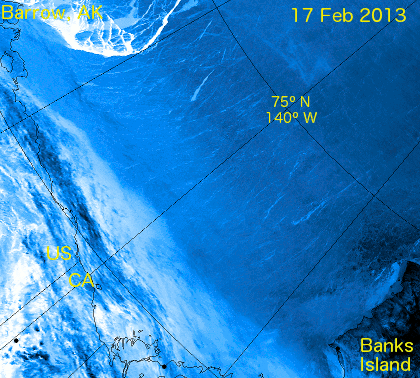It started with an unusual storm that passed over the North Pole on Feb. 8. The National Snow and Ice Data Center says it caused the sea ice to crack, and the cracks to spread in a curving pattern, from the tip of Alaska to Canada. Similar patterns have appeared in the past, though not of this scale.
What usually happens is the leads freeze back up, but Assistant Professor Andy Mahoney of the University of Alaska Fairbanks Geophysical Institute just got back from several days of helicopter overflights out of Barrow.
“This year it’s been pretty persistent, and I think that’s really what marks this year as being different from the other examples that we’ve seen,” Mahoney said.

Geologist Richard Glenn of the Barrow Arctic Science Consortium has been watching the sea ice phenomenon closely.
“It’s basically unzipped the whole ice cover along the coast from Cape Lisburne all the way to the Canadian high Arctic, and we saw it here,” Glenn said. “It was impossible to miss of course.”
There has been a trend of sea ice freezing up later and breaking up earlier for decades, but the ice has also been getting thinner. And in recent years, the remaining thicker ice, formed over a period of several years, has been breaking up and flushing out. Mahoney says this winter, their intensive helicopter search found none at all.
“We went looking for multi-year ice, we were hoping to find maybe some small isolated floes that the satellites hadn’t picked up, and we didn’t see any sign of multi-year ice,” Mahoney said. “So we do believe that the Beaufort at the moment is pretty much devoid of multi-year ice.”
There is plenty of theory, but the reality is that nobody knows how this thinner, so-called “new” ice is going to behave. The giant leads that appeared in February may have been triggered by a storm, but their persistence could have more to do with the ocean’s internal heat dynamics. Warm water flows into the Arctic from the south, but it mostly stays deep, with colder meltwater on top of it. With less ice, the ocean is darker and that upper layer absorbs more heat from the sun. Scientists have not been able to pin down which heat source might be involved in weakening the winter ice.
One thing Mahoney knows for sure is that warm water has shown up right next to shore at Barrow.
“We have a measurement site in the landfast ice at Barrow, and what we observed just a few weeks ago was actually melting of the ice, even in winter,” Mahoney said. “And we saw five centimeters of melt, in pretty much just a single day, and that appears to be related to a warm pulse of water passing underneath the ice.”
That open water is right in front of town, says Richard Glenn.
“And we don’t even need the space images to see it,” Glenn said. “It’s right in front of our front window.”
Subsistence whalers are concerned about the open water lead. They can usually count on a sturdy layer of ice along the shore that allows them to travel out to set up their camps near the Bowheads’ migration path, but longtime North Slope Borough whale biologist Craig George says this year is different.
“You know the ice broke right to the beach, which typically doesn’t happen,” George said. “It didn’t happen in the past as much, when there was heavy multi-year ice mixed in with the landfast ice.”
The ocean’s heat budget is at the root of a major dispute between climate scientists. Computer modelers expect an ice-free Arctic by 2030 or 2040, but a growing number of field scientists say there must be some things the modelers do not understand about local conditions and they expect ice free conditions within just a few years.
sheimel (at) alaskapublic (dot) org | 907.550.8454 | About Steve




